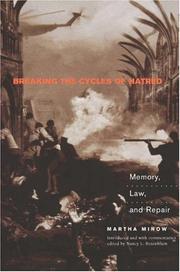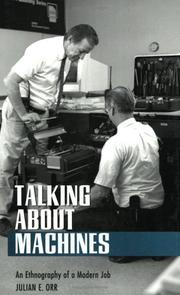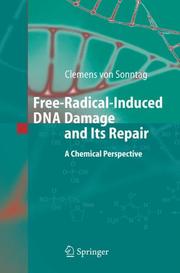| Listing 1 - 6 of 6 |
Sort by
|
Book
ISBN: 9780323478588 0323478581 9780323478281 032347828X 9780323609654 0323609651 0323478336 9780323478335 Year: 2019 Publisher: St. Louis, Missouri : Elsevier,
Abstract | Keywords | Export | Availability | Bookmark
 Loading...
Loading...Choose an application
- Reference Manager
- EndNote
- RefWorks (Direct export to RefWorks)
Dentistry, Operative. --- Operative Dentistry --- Surgery, Oral --- Dental surgery --- Dentistry, Restorative --- Operative dentistry --- Restorative dentistry --- Surgery, Dental --- Dentistry, Operative --- Fillings (Dentistry) --- Dentisterie opératoire. --- Réparation de restauration dentaire. --- Chirurgie dentaire --- Restauration dentaire
Book
ISBN: 1282400665 9786612400667 9047425723 9789047425724 9789004172258 9004172254 9781282400665 6612400668 Year: 2009 Publisher: Leiden ; Boston : Brill,
Abstract | Keywords | Export | Availability | Bookmark
 Loading...
Loading...Choose an application
- Reference Manager
- EndNote
- RefWorks (Direct export to RefWorks)
No legal system in the world has aroused as much public interest as Sharia. However, the discourse around Sharia law is largely focussed on its development and the theories, principles and rules that inform it. Less attention has been given to studying the consequences of its operation, particularly in the area of Islamic criminal law. Even fewer studies explore the actual practice of Islamic criminal law in contemporary societies. This book aims to fill these gaps in our understanding of Sharia law in practice. It deals specifically with the consequences of enforcing Islamic criminal law in Pakistan, providing an in-depth and critical analysis of the application of the Islamic law of Qisas and Diyat (retribution and blood money) in the Muslim world today. The empirical evidence adduced more broadly demonstrates the complications of applying traditional Sharia in a modern state.
Blood money (Islamic law) --- Criminal justice, Administration of (Islamic law) --- Criminal justice, Administration of --- Islamic law --- Punishment (Islamic law) --- Reparation (Criminal justice) --- Reparation (Islamic law) --- Droit pénal (Droit islamique) --- Justice pénale --- Peines (Droit islamique) --- Prix du sang (Droit islamique) --- Réparation (Droit islamique) --- Réparation (Droit) --- Dīyah (Islamic law) --- Diyat (Islamic law) --- Administration of criminal justice --- Justice, Administration of --- Crime --- Criminal law --- Criminals --- Compensation for victims of crime --- Criminal restitution --- Reparation --- Restitution (Criminal justice) --- Restitution for victims of crime --- Remedies (Law) --- Administration --- Law and legislation --- Droit islamique --- Administration (Droit islamique)

ISBN: 0691096627 0691096635 9786612087677 9786612935305 1282935305 1282087673 1400825385 9781400825387 9780691096629 9780691096636 9781282087675 9781282935303 6612935308 6612087676 Year: 2002 Publisher: Princeton, N.J. : Princeton University Press,
Abstract | Keywords | Export | Availability | Bookmark
 Loading...
Loading...Choose an application
- Reference Manager
- EndNote
- RefWorks (Direct export to RefWorks)
Violence so often begets violence. Victims respond with revenge only to inspire seemingly endless cycles of retaliation. Conflicts between nations, between ethnic groups, between strangers, and between family members differ in so many ways and yet often share this dynamic. In this powerful and timely book Martha Minow and others ask: What explains these cycles and what can break them? What lessons can we draw from one form of violence that might be relevant to other forms? Can legal responses to violence provide accountability but avoid escalating vengeance? If so, what kinds of legal institutions and practices can make a difference? What kinds risk failure? Breaking the Cycles of Hatred represents a unique blend of political and legal theory, one that focuses on the double-edged role of memory in fueling cycles of hatred and maintaining justice and personal integrity. Its centerpiece comprises three penetrating essays by Minow. She argues that innovative legal institutions and practices, such as truth commissions and civil damage actions against groups that sponsor hate, often work better than more conventional criminal proceedings and sanctions. Minow also calls for more sustained attention to the underlying dynamics of violence, the connections between intergroup and intrafamily violence, and the wide range of possible responses to violence beyond criminalization. A vibrant set of freestanding responses from experts in political theory, psychology, history, and law examines past and potential avenues for breaking cycles of violence and for deepening our capacity to avoid becoming what we hate. The topics include hate crimes and hate-crimes legislation, child sexual abuse and the statute of limitations, and the American kidnapping and internment of Japanese Latin Americans during World War II. Commissioned by Nancy Rosenblum, the essays are by Ross E. Cheit, Marc Galanter, Fredrick C. Harris, Judith Lewis Herman, Carey Jaros, Frederick M. Lawrence, Austin Sarat, Ayelet Shachar, Eric K. Yamamoto, and Iris Marion Young.
Hate crimes. --- Violence (Law). --- Reparation (Criminal justice) --- Law reform. --- Crimes haineux . --- Violence --- Réparation (Droit) --- Droit --- Réforme --- Hate crimes --- Violence (Law) --- Law reform --- Réparation (Droit) --- Réforme --- Force (Law) --- Compensation for victims of crime --- Criminal restitution --- Reparation --- Restitution (Criminal justice) --- Restitution for victims of crime --- Legal reform --- Bias crimes --- Bias-related crimes --- Hate-motivated crimes --- Hate offenses --- Law --- Remedies (Law) --- Crime

ISBN: 9781501707407 150170740X 1501707396 0801432979 9780801432972 0801483905 9780801483905 9781501707391 Year: 1996 Publisher: Ithaca, [New York] ; London, [England] : ILR Press,
Abstract | Keywords | Export | Availability | Bookmark
 Loading...
Loading...Choose an application
- Reference Manager
- EndNote
- RefWorks (Direct export to RefWorks)
This is a story of how work gets done. It is also a study of how field service technicians talk about their work and how that talk is instrumental in their success. In his innovative ethnography, Julian E. Orr studies the people who repair photocopiers and shares vignettes from their daily lives. He characterizes their work as a continuous highly skilled improvisation within a triangular relationship of technician, customer, and machine. The work technicians do encompasses elements not contained in the official definition of the job yet vital to its success. Orr's analysis of the way repair people talk about their work reveals that talk is, in fact, a crucial dimension of their practice. Diagnosis happens through a narrative process, the creation of a coherent description of the troubled machine. The descriptions become the basis for technicians' discourse about their experience, and the circulation of stories among the technicians is the principal means by which they stay informed of the developing subtleties of machine behavior. Orr demonstrates that technical knowledge is a socially distributed resource stored and diffused primarily through an oral culture. Based on participant observation with copier repair technicians in the field and strengthened by Orr's own years as a technician, this book explodes numerous myths about technicians and suggests how technical work differs from other kinds of employment.
E-books --- Photocopying machines --- Mechanics --- Ethnology --- Maintenance and repair --- Xerox Corporation --- Customer services. --- United States --- Customer services --- Classical mechanics --- Newtonian mechanics --- Physics --- Dynamics --- Quantum theory --- Photocopiers --- Copying machines --- Maintenance and repair. --- Haloid Xerox, Inc. --- Mechanical engineering --- Business anthropology --- Génie mécanique --- Photocopieurs --- Affaires --- Entretien et réparation --- Aspect anthropologique --- Photocopying machines - United States - Maintenance and repair --- Mechanics - United States --- Ethnology - United States
Periodical
Abstract | Keywords | Export | Availability | Bookmark
 Loading...
Loading...Choose an application
- Reference Manager
- EndNote
- RefWorks (Direct export to RefWorks)
Mutation (Biology) --- DNA repair --- Mutation --- DNA Repair --- Mutation (Biologie) --- ADN --- Réparation --- Base Excision Repair --- Excision Repair --- Nucleotide Excision Repair --- Base Excision Repairs --- Excision Repair, Base --- Excision Repair, Nucleotide --- Excision Repairs --- Nucleotide Excision Repairs --- Repair, Base Excision --- Repair, Excision --- Repairs, Base Excision --- Mutations --- Deoxyribonucleic acid repair --- Repair, DNA --- Repair mechanisms in DNA --- DNA-Formamidopyrimidine Glycosylase --- DNA Repair Enzymes --- Targeted Gene Repair --- DNA Damage --- Polymorphism, Restriction Fragment Length --- Biochemical genetics --- Antimutagens --- Genetics --- Variation (Biology) --- Mutation. --- DNA Repair.

ISBN: 9783540261209 3540261206 3642065546 9786610607907 1280607904 3540305920 Year: 2006 Publisher: Berlin ; New York : Springer,
Abstract | Keywords | Export | Availability | Bookmark
 Loading...
Loading...Choose an application
- Reference Manager
- EndNote
- RefWorks (Direct export to RefWorks)
Understanding of the molecular basis of DNA damage and its repair has increased dramatically in recent years, and substantial knowledge now exists concerning the products arising from free-radical attack on DNA. Free-radical DNA damage may lead to mutations, cancer, and cell death. Free radicals have various sources, notably ionizing radiation and oxidative stress. In radiotherapy for cancer and with some anticancer drugs, use is made of cell death by excessive DNA damage. The mechanisms leading to products of free-radical attack which have been studied in models and with small double-stranded DNA fragments are discussed in detail, and the basics of the underlying free-radical chemistry are dealt with in separate chapters.
DNA damage --- DNA repair --- Free radicals (Chemistry) --- ADN --- Radicaux libres (Chimie) --- Lésions --- Réparation --- DNA damage. --- Biochemical Processes --- Organic Chemicals --- Genetic Processes --- Inorganic Chemicals --- Chemical Processes --- Chemicals and Drugs --- Biochemical Phenomena --- Genetic Phenomena --- Chemical Phenomena --- Phenomena and Processes --- DNA Repair --- Free Radicals --- DNA Damage --- Biology --- Health & Biological Sciences --- Genetics --- Cytology --- DNA repair. --- Free radicals (Chemistry). --- Lésions --- Réparation --- EPUB-LIV-FT LIVBIOLO SPRINGER-B --- Deoxyribonucleic acid repair --- Repair, DNA --- Repair mechanisms in DNA --- Damage, DNA --- Life sciences. --- Molecular biology. --- Organic chemistry. --- Oncology. --- Biochemistry. --- Cell biology. --- Life Sciences. --- Biochemistry, general. --- Cell Biology. --- Life Sciences, general. --- Molecular Medicine. --- Organic Chemistry. --- Radicals (Chemistry) --- Free radical reactions --- Biochemical genetics --- Antimutagens --- Mutation (Biology) --- Cytology. --- Medicine. --- Oncology . --- Chemistry, Organic. --- Organic chemistry --- Chemistry --- Tumors --- Clinical sciences --- Medical profession --- Human biology --- Life sciences --- Medical sciences --- Pathology --- Physicians --- Biosciences --- Sciences, Life --- Science --- Cell biology --- Cellular biology --- Cells --- Cytologists --- Biological chemistry --- Chemical composition of organisms --- Organisms --- Physiological chemistry --- Composition --- Health Workforce --- Molecular biochemistry --- Molecular biophysics --- Biochemistry --- Biophysics --- Biomolecules --- Systems biology
| Listing 1 - 6 of 6 |
Sort by
|

 Search
Search Feedback
Feedback About UniCat
About UniCat  Help
Help News
News